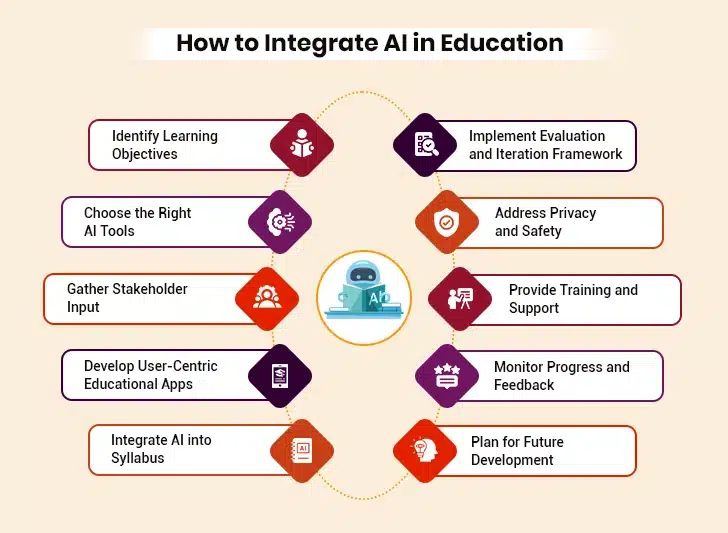Imagine a classroom where every student learns at their own pace, with lessons tailored just for them. This isn’t a dream anymore; it’s the reality of education today. Thanks to AI advancements in the education space. Artificial Intelligence is transforming the way students learn by making education more fun and interactive. However, the impact of AI is not just limited to smart classrooms. It’s helping make quality education accessible to all, no matter where they live. This means students from across the world can access the same learning opportunities. This detailed post will walk you through the benefits and challenges of AI in education. The post also delves into the real-life applications of Artificial Intelligence in education.
Table of Contents
10 Key Benefits of AI Technology in Education
AI Technologies Transforming the Education Industry
How to Integrate AI in Education: Follow This Simple 10 Step Approach
Real-Life Applications of Artificial Intelligence for Education
Challenges of Using Artificial Intelligence in Education
Summing Up
10 Key Benefits of AI Technology in Education
AI in education offers a range of benefits, comprising personalized learning, increased engagement, career guidance, and more. Let’s take a more detailed look at some of the key benefits:
1. Personalized Learning
Artificial intelligence in education helps tailor content to the learning pace of students. Owing to this, every student can master concepts at their own speed. This makes learning more effective and engaging. Here are some key benefits of personalized learning.
- Personalized lesson plans based on individual learning style
- Real-time feedback to correct mistakes quickly
- Adaptive difficulty to match the student’s learning pace
- Engagement through customized content
- Improved outcomes due to tailored learning
- Efficient use of time for teachers
2. Automated Administrative Tasks
AI offloads regular admin tasks from grading to report generation. This lessens the workload on educators while allowing them to focus more on teaching. Given below are the key benefits of automated admin tasks.
- Efficient grading with consistent results
- Optimized scheduling for better resource allocation
- Reduced bureaucracy for teachers
- Increased productivity for educators
- Improved accuracy in administrative tasks
- Enhanced student experience through more teacher interaction
3. 24×7 Tutoring Support
AI systems offer constant assistance to students, providing help with homework and explaining difficult concepts. This support is available anytime, anywhere. Let’s explore the key benefits of regular tutoring support.
- Accessibility to help at any time
- Personalized help based on individual needs
- Increased confidence with constant support
- Reduced teacher workload
- Improved retention with immediate help
- Enhanced engagement through continuous support
4. Improved Accessibility
AI offers quick access to premium educational resources regardless of economic status or geographic location. This helps bridge educational gaps. Here are the key benefits of improved accessibility.
- Global reach with accessible AI tools
- Cost-effective solutions for education
- Equal opportunities for all students
- Increased enrollment due to accessibility
- Better outcomes from quality resources
- Reduced inequality in education
5. Regular Assessment and Feedback
AI provides regular feedback on student learning performance. This helps determine strengths and shortcomings, improving learning outcomes. Listed below are the key benefits of regular assessment.
- Immediate feedback for quick corrections
- Data-driven insights into student progress
- Teacher support for targeted interventions
- Enhanced learning through timely feedback
- Better academic performance with real-time assessment
- Proactive approach to education
6. Enhanced Engagement and Motivation
AI creates engaging learning environments through gamification and interactive tools. This increases student engagement and participation. Let’s discover the key benefits of enhanced engagement.
- Interactive learning through immersive technologies
- Gamification for increased engagement
- Virtual and augmented reality experiences
- Personalized challenges to match abilities
- Increased participation in interactive learning
- Improved retention through engaging environments
7. Career Guidance and Planning
AI analyzes data to provide students with career guidance and trend insights. This guidance is especially useful when combined with academic advising. Here are the key benefits of career guidance and planning.
- Data analysis for job market trends
- Personalized advice based on individual interests
- Future planning with AI insights
- Skill development for future jobs
- Informed decisions about career paths
- Increased confidence in career choices
8. Free or Low-Cost Academic Support
AI reduces financial barriers by offering free or low-cost research assistance and editing tools. This increases access to educational resources. Given below are the key benefits of low-cost academic support.
- Cost savings for students
- Increased access to quality support tools
- Improved research with AI assistance
- Enhanced writing skills through AI tools
- Fair opportunities for all students
- Better academic performance with affordable support
9. Analysis of Learning Gaps
AI tools can quickly spot the gaps where students need improvement. This helps educators tailor their teaching and provide more effective support. Let’s explore the key benefits of analysis of learning gaps.
- Rich data insights into student performance
- Identifying weaknesses in student knowledge
- Targeted teaching for specific areas
- Improved outcomes by addressing gaps
- Efficient use of teacher time
- Enhanced student progress through continuous monitoring
10. Build Core Competencies
AI helps students nurture core expertise, entailing digital literacy, critical thinking, and creativity. These core skills are needed for future success. Here are the key benefits of building core expertise.
- Digital literacy through AI tools
- Critical thinking encouraged by AI
- Creativity fostered through AI platforms
- Problem-solving skills developed with AI
- Future readiness with essential skills
- Competitive advantage in the job market
5 Ways Generative AI is Redefining the Education System
AI Technologies Transforming the Education Industry
The role of AI in education is transformative. Explore how popular AI technologies are transforming the education space.
| AI Technology | Transformation in Education |
| Machine Learning | Enhances personalized learning experiences |
| Natural Language Processing | Improves language learning and accessibility |
| AI Chatbots | Provides quick support and assistance |
| Intelligent Tutoring Systems | Offers tailored guidance and feedback |
| Speech Recognition | Facilitates voice-based interactions and accessibility |
| Learning Management Systems | Streamlines administrative tasks and course management |
How to Integrate AI in Education: Follow This Simple 10 Step Approach
Listed below are the simple steps that schools, colleges, and universities may follow for smooth integration of AI in education.
Identify Learning Objectives
Identify areas where AI can improve learning and teaching. Work with educators to devise how AI can enhance specific subjects or expertise.
Choose the Right AI Tools
Select AI tools that fit your educational goals and budget. Consider tools like chatbots, learning analytics, and AI content recommendations.
Gather Stakeholder Input
Engage faculty, staff, and students in the decision-making process. Understand their needs, concerns, and expectations regarding AI integration.
Develop User-Centric Educational Apps
Build apps with dynamic interfaces and accessible content. Incorporate features like support for multiple languages.
Integrate AI into Syllabus
Use AI to improve lessons, not replace them. Focus on personalized learning and interactive activities.
Implement Evaluation and Iteration Framework
Create a system for developing, testing, and rolling out new AI features. Involve educators, students, and developers in the process.
Address Privacy and Safety
Make sure AI is used safely and responsibly. Protect student privacy and follow ethical laws.
Provide Training and Support
Offer training for educators on AI tools by collaborating with an AI development company. Support ongoing learning and adaptation.
Monitor Progress and Feedback
Regularly assess how AI is working and gather feedback. Use insights to improve AI integration and address challenges.
Plan for Future Development
Stay aware of new AI tools and trends. Plan for future integration to keep enhancing education.
Exploring the Limitless Potential of Artificial Intelligence Across Industries
Real-Life Applications of Artificial Intelligence for Education
There are many educational applications out there that are already using artificial intelligence. Let’s look at some successful educational applications that make learning more enjoyable through AI.
I. Khanmigo for Personalized Tutoring
Khanmigo is an AI-powered personal tutor engineered by Khan Academy. It provides personalized assistance in subjects like math and reading. This helps teachers create tailored lesson plans.
| Khanmigo Pros | Khanmigo Cons |
| Personalized assistance | Limited to specific subjects |
| Enhances student understanding | Requires good internet connection |
| Supports teachers in planning | May not replace traditional teaching |
| Available for parents too | Limited support for advanced learners |
| Improves academic performance | Can be complex to use for some teachers |
II. Duolingo for Language Learning
Duolingo uses AI to personalize language learning. It adjusts the difficulty level as students’ progress. This helps them stay motivated but not overwhelmed. The app is popular for its engaging approach to language education.
| Duolingo Pros | Duolingo Cons |
| Engaging interface | Limited depth in some languages |
| Personalized learning | Not suitable for advanced learners |
| Accessible on mobile | Requires consistent practice |
| Motivational rewards | Limited human interaction |
| Cost-effective | May not cover all grammar rules |
III. Blue Canoe for English Speaking
Blue Canoe helps students improve spoken English skills using AI speech recognition. It offers personalized feedback on pronunciation.
| Blue Canoe Pros | Blue Canoe Cons |
| Personalized feedback | Limited to English language |
| Improves pronunciation | Requires consistent practice |
| Engaging exercises | Not suitable for all accents |
| Accessible on mobile | Limited human interaction |
| Cost-effective | May not cover advanced grammar |
IV. Amira Learning for Reading
Amira Learning uses AI to help young students improve their reading skills. It listens to them read aloud and provides feedback. Amira also offers reports on student progress and checks for signs of dyslexia. By using AI, Amira makes reading practice more interactive and effective. This helps students become better readers over time.
| Amira Learning Pros | Amira Learning Cons |
| Identifies learning gaps | Requires internet access |
| Real-time feedback | May not replace human teaching entirely |
| Supports dyslexia screening | Can be expensive for some schools |
| Enhances reading fluency | Limited support for advanced readers |
| Provides progress reports | Limited availability in some regions |
V. Century Tech for Personalized Learning
Century Tech creates personalized learning plans using AI. It identifies knowledge gaps and offers tailored resources.
| Century Tech Pros | Century Tech Cons |
| Reduces teacher workload | May not be ideal for all learning styles |
| Identifies learning gaps | Limited support for non-core subjects |
| Personalized learning plans | Can be complex to implement |
| Enhances student engagement | Requires significant data collection |
| Improves academic outcomes | Can be expensive for some schools |
VI. Carnegie Learning for Math and Literacy
Carnegie Learning uses AI to personalize math and literacy education. It adapts lessons based on student performance and learning habits. The app is useful for students who need a deeper understanding of these subjects.
| Carnegie Learning Pros | Carnegie Learning Cons |
| Personalized learning | Limited support for other subjects |
| Enhances understanding | May not replace traditional teaching |
| Adapts to student pace | Requires a good internet connection |
| Improves academic performance | Limited availability in some regions |
| Engaging interactive content | Can be expensive for some schools |
VII. Grammarly for Writing Enhancement
Grammarly uses AI to improve writing skills by correcting grammar and suggesting improvements.
| Grammarly Pros | Grammarly Cons |
| Enhances writing quality | Limited to writing skills |
| Provides instant feedback | May not cover all nuances of language |
| Accessible on mobile | Limited support for creative writing |
| Improves clarity and coherence | Can be over-reliant on AI suggestions |
| Cost-effective | Requires internet access |
VIII. Blippar for Interactive Learning
Blippar uses AI to improve learning with augmented reality. It creates interactive materials for subjects like geography and biology. This approach helps students understand complex concepts better and makes learning more enjoyable.
| Blippar Pros | Blippar Cons |
| Encourages curiosity | Can be distracting if overused |
| Enhances engagement | May not be ideal for all learning styles |
| Improves understanding | Can be expensive to implement |
| Makes complex concepts accessible | Limited availability in some subjects |
| Interactive learning | Requires specific hardware |
IX. Cognii for Critical Thinking
Cognii uses AI to aid students in critical thinking exercises. It offers instant feedback, helping students augment their skills. The app is used in both K-12 and higher education.
| Pros | Cons |
| Real-time feedback | Limited support for advanced learners |
| Personalized tutoring | Can be expensive for individual use |
| Enhances critical thinking | May not replace human interaction entirely |
| Supports various subjects | Limited availability in some regions |
| Improves student engagement | Requires internet access |
X. Quizlet’s Adaptive Learning
Quizlet uses AI to provide adaptive study plans. It helps students focus on areas that require improvement. The app is widely used for subjects like history, science, and languages.
| Quizlet Pros | Quizlet Cons |
| Identifies knowledge gaps | Can be distracting if overused |
| Enhances student engagement | May not be ideal for all learning styles |
| Adaptive learning plans | Limited depth in some subjects |
| Improves retention | Requires internet access |
| Accessible on mobile | Limited support for advanced learners |
Challenges of Using Artificial Intelligence in Education
Though the benefits of AI in education are wide and impactful, there are also some challenges surrounding it that need your attention. Here’s a more detailed look at the challenges along with their solutions.
I. Bias in AI Systems
Challenge: AI systems can sometimes provide biased information or learning materials, which may not fairly represent all groups. This can affect the quality of education.
Solution: Make sure AI models are fair and transparent. Regularly check and update educational content to include different viewpoints and ensure fairness.
II. Data Security
Challenge: Excess use of AI might increase the risk of cyberattacks and data breaches.
Solution: Use robust security measures and update them regularly. Educate staff and students about safe online practices and the risks of using AI in excess.
III. Digital Divide
Challenge: Not all students have the same access to the internet connection needed for AI learning tools.
Solution: Try to bridge the gap by providing affordable internet access to students who may need it. Governments and private players can join hands together to improve internet access in rural areas.
IV. Relying on AI Excessively
Challenge: If students rely too much on AI, they might not learn to solve problems on their own. This may result in poor performance in examinations.
Solution: Encourage students to use AI to get ideas and do research, but make them develop those ideas on their own. This helps them use technology but still learn in the traditional way.
V. Academic Dishonesty
Challenge: Students might use AI to write assignments or exam papers. This may lead to academic misconduct.
Solution: Set clear rules and educate students on how to use AI responsibly. Change assessments to focus on applying knowledge instead of just memorizing facts.
VI. Lack of Human Interaction
Challenge: Overuse of AI reduces engagement between students and teachers.
Solution: Balance AI use with traditional teaching methods that involve human interactions. Encourage group projects and discussions to help students learn to work together.
VII. Lack of Transparency in AI Algorithms
Challenge: It’s often difficult to understand how AI algorithms make decisions. This may lead to mistrust and potential misuse.
Solution: Ask AI developers to remain transparent about how their algorithms work. Make sure educators understand these processes so they can make good decisions.
Summing Up
AI is changing education in many positive ways. It lowers the administrative burden for teachers by automating tasks like grading and reporting. This allows them to focus more on teaching. AI also creates interactive learning experiences using tools like virtual reality. This makes learning more engaging and fun. As AI continues to evolve, it will play an even bigger role in shaping the future of education. If you want to make the most of AI in education, you may seek help from a reliable partner.







